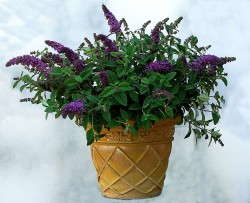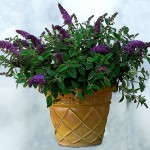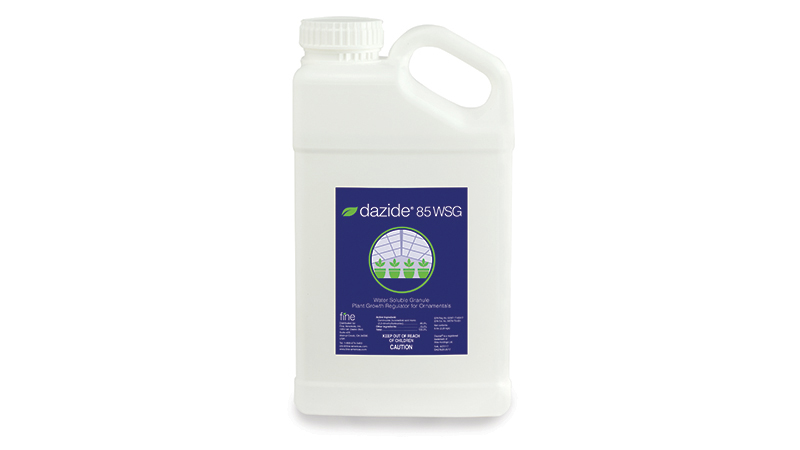Low-Moisture, Heat-Tolerant Plants

Pretty isn’t enough for perennials and shrubs anymore. They also need to be drought tolerant and heat resistant and produce abundant, fragrant flowers over a long bloom time. Oh, and it’d be great if they attracted butterflies, bees or other beneficial wildlife, too.
It’s a tall order, but perennial and shrub breeders are rising to the challenge with new plants that meet the heightened expectations of consumers.
Jimmy Turner, senior director of gardens for the Dallas Arboretum and Botanical Society, trials hundreds of new varieties every year and is one of the first to see industry trends. He says heat tolerance and low water are the big requirements now, and there’s also been a huge amount of breeding lately around scented plants, as well as plants that attract wildlife.
“[Consumers want to know that] this is a food source for such-and-such butterfly, or this is a host for such-and-such beneficial insect,” Turner says. “Ten years ago nobody would have ever mentioned ‘this plant attracts bees,’ because you didn’t want anyone to think it did. Now, all of a sudden, having bees in your backyard is a badge of honor.”
Many breeders are working with some tried and true older favorites such as hollyhock and hibiscus.
“They’re taking an old staple that we all know we can’t kill and saying, ‘Let’s see what we can do to improve it,’” Turner says.
He cites the hibiscus Summerific series from Walters Gardens as one example.
“It flowers from the bottom up – not just at the top of the stems,” he says. “There is a flower at every node.”
Turner likes ‘Berrylicious,’ with its huge 8- to 9-inch diameter mauve lavender flowers with a deep red eye. He also likes ‘Jazzberry Jam,’ with bright magenta, slightly ruffled flowers.
Another old favorite Turner likes “that we’re all sort of gaga over right now” is chaenomeles ‘Double Take,’ a double-flowered thornless cultivar bred by Spring Meadow Nursery. He is also enthusiastic about two new oakleaf hydrangeas, ‘Munchkin’ and ‘Ruby Slippers,’ out of the Tennessee State University Otis Floyd Nursery Crop Research Center.
“For us, oakleaf hydrangeas have always been 8 to 9 feet tall. These are in the 3 to 4 foot range – tight, compact. The flowers start out white, then turn into this beautiful rosy, reddish pink,” Turner says.
The Most Popular Perennials
Asked if there is one genus that stands out above all others in popularity, Turner answers without hesitation.
“In the perennial world right now it’s echinaceas,” he says. “I think we have more than 500 varieties of echinaceas right now.”
Some of his favorites that are doing well in trials are ‘Cheyenne Spirit’ (PanAmerican Seed), a multicolor blend of orange, yellow and red, and Terra Nova’s new Secret series.
“They’ve got a new yellow called ‘Leilani,’ which has huge yellow, hand-sized – and I’ve got big hands – flowers on it,” he says. “‘Southern Belle’ from Plants Nouveau is another stunner. [It’s] absolutely gorgeous. It’s kind of a bicolor pink – just sexy.”
Hellebores are right behind echinaceas in new breeding.
“There’s a few hundred of them coming out of Germany from a company named Heuger,” Turner says. “Skagit [Gardens] is the American grower and tester. They’ve got some wonderful new stuff there.”
One new series, the Gold Collection, features more bronzy foliage with silver marbling, bigger flowers and more heat tolerance and vigor. Another standout (though not in the Gold Collection) is ‘Penny’s Pink.’
“It’s a beautiful, deep rosy purple-pink with a cup-shaped flower. It makes jillions of them,” Turner says.
Dianthus is also getting a lot of attention from breeders, and Turner says one that has performed especially well in his trials is dianthus ‘Early Bird’ in the Scent series from PlantHaven.
“It’s compact, heavy blooming and has great flower production. They made it through the hottest summer on record this year in Texas, so I think they could grow anywhere. They’re super hardy too,” he says.
Buddleias & Bloomtastic
Joe Gray, senior vice president of Hines Nurseries, has two brand-new buddleias that also meet consumer demand for low-moisture, heat-tolerant, fragrant, wildlife-attracting plants. Buddleia ‘Lavender Veil’ is only 18 to 24 inches tall, making it a versatile plant even for those with small gardens. And unlike most buddleias, it flowers all over the shrub, not just at the top.
“It’s extremely fragrant and just
keeps blooming,” Gray says. “Even though it’s a woody shrub, it is acting more like a perennial.”
‘Lavender Veil’ may have another use, too. “When I’ve showed the plants to people coming into Hines, half of them have said, ‘That would be a good hanging basket.’ It’s in their thought process already, so I’m sure consumers would think that too,” he says.
Buddleia ‘Purple Splendor’ is slightly larger at 3 feet but it is still quite compact, Gray says.
“It’s full to the base and has really deep purple flowers. It blooms all summer, with lots of fragrance. It’s a manageable plant you can use in a foundation planting.”
Hines also has new introductions in its Bloomtastic program, which includes only plants with fantastic, long-lasting blooms and ease of care.
“We as an industry make it complicated for the consumer,” Gray says. “We really need to take that out and make it as fun an experience as possible. Bloomtastic is fun, simple and these plants are going to perform.”
One of Gray’s favorites is crinum ‘Purple Dream,’ which combines black-purple foliage with a striking pink flower.
“It’s a fantastic plant,” he says, adding that it looks like a cordyline, but with a beautiful flower. “In addition to that, it’ll grow in almost standing water – it will take dry soil too, so it’s a very tolerant plant – and it’s very difficult to kill. It makes a great patio plant in a big container. We’re psyched about that.”
Bougainvillea ‘Bambino’ and its even smaller counterpart ‘Babybino’ are also new to the Bloomtastic line. The Bambinos reach 4 to 5 feet tall. They have a compact habit and come in eight different colors. The Babybinos are even smaller.
“They are perfect for the deck or patio,” Gray says. “[And] the Babybinos can be used in mixed planter and windowboxes – they’re so diminutive and small.”
What’s New At Walters?
Walters Gardens also has some unique new perennials, some of which are being introduced via its new partnership with Proven Winners.
Hemerocallis ‘Primal Scream’ is one such perennial. It’s not just another daylily. Winner of the 2003 Stout Medal (the highest honor a daylily can receive), it has huge 7 ½- to 8 ½-inch diameter tangerine-orange flowers with a green throat.
In rudbeckias, a new introduction threatens to turn ‘Goldsturm’s long dominance of the rudbeckia market on its head. Rudbeckia fulgida var. sullivantii ‘Little Goldstar’ is more compact and just over 12 inches tall.
“The flowers are closely spaced and held just above the foliage,” says Susan Martin, director of marketing communications for Walters Gardens. “It looks fantastic in containers at retail and in the garden. Since this variety is produced by tissue culture, the plants will be much more uniform than the seed-grown ‘Goldsturm,’ resulting in fewer losses for growers.”
Ligularia ‘Bottle Rocket’ also features a compact habit – one not usually seen in ligularias.
“This sport of ‘Little Rocket’ was discovered right here at Walters Gardens,” Martin says. “Unlike older ligularias, this one is a perfectly proportioned plant with its mustard yellow flowers held just at the top of the foliage.”
About six inches shorter than its parent, ‘Bottle Rocket’ is also more robust, with thicker leaves that stand up to the heat.
Martin is also excited about alstromeria ‘Inca Ice.’
“We’ve watched this plant growing in our shade trials for a few years and have been impressed every year with its vigor and capacity to produce loads of flowers over a long period,” she says.
The flowers have alternating petals of apricot pink and creamy yellow with brown speckling, and she has seen 20 or more on one stem.
“Although the plants in the Inca Collection were bred specifically for
garden use rather than the floral industry, the stems are still plenty long enough for cutting,” Martin says.










